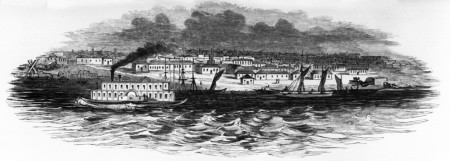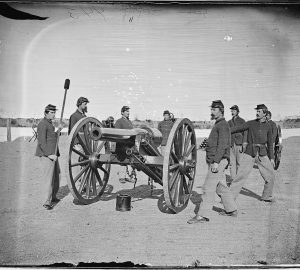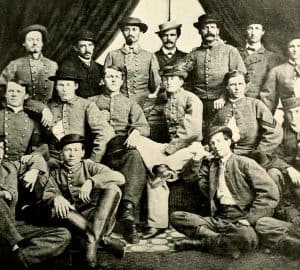
The largest of the Confederate States of America by far was Texas, and although Texans fought in every major battle of the Civil War, their home state would see nearly no fighting. It was still nearly the frontier in the 1860s, and out of the course of the military campaigns. But there were a few exceptions to this rule, and one of those was the fighting over Galveston. The island of Galveston was first settled by Europeans in 1816, but they were pirates – far from your usual settlers. Jean Lafitte maintained a pirate kingdom there for several years until driven off by the US Navy. A town developed there, and undertaking more reputable business, it became the largest and wealthiest city, as well as the busiest sea port in Texas. It was an obvious target for the Union navy.
The Confederate government appointed former governor of Louisiana, Brigadier General Paul Hébert to command in Texas, and he found Galveston’s defenses virtually nonexistent, and was convinced it would be impossible to defend the place. But he put up gun batteries on the coastline to ward of Union ships, being especially careful to protect the railroad bridge, which connected the island with the mainland.

The first two Federal ships were sighted off Galveston on July 2, 1861, and they came close and traded fire with the town’s batteries. Over the next for months more Federal ships would arrive, and help establish a blockade. They were able to keep out most of the commerce that had flowed to the port, though they could do little against the blockade runners that quickly slipped by them. But the Northerners would do more than blockade. On May 17, 1862, Captain Henry Eagle of the United States navy sent a message to the Confederate commander announcing that “in a few days the naval and land forces of the United States Government will appear off the town of Galveston to enforce its surrender,” and demanded the surrender of the town “to prevent the effusion of blood and destruction of property.”1 Although Hébert determined not to surrender, he did not believe the city could be held, and ordered his troops to prepare to abandon the their positions if an overwhelming force appeared. But the promised attach never came – at least not from those Federal warships. They ran out of food, and Galveston was safe for the time.

Larger Union ships were sent to Galveston, and they were put under the commander of Commodore William Renshaw a favorite of David Farragut. Farragut told him, “Galveston appears to be the port most likely for you to be able to enter, if the forts are not too formidable.”2 Renshaw arrived off Galveston with eight ships on October 4. He bombarded a few Confederate batteries and reduced them to ruins, convincing the pessimistic Hébert to abandon the city. On the 9th a Union boat came ashore and took possession of the city. The citizens were disgusted that the Queen City of the Gulf had been surrendered to a “mosquito fleet.” The government in Richmond was disappointed in Hébert, and the day after the surrender he was replaced with John Bankhead Magruder. “Prince John,” as he was known, had although he performed poorly in the Seven Days campaigns, he had done well on the Penninsula, convincing the Federal forces not to attack by convincing them he had many more troops than he actually did.

The dramatic Magruder began making plans to recapture Galveston, which he regarded as the key to the state. He planned to attack using land and naval forces. The infantry and artillery would cross the railroad bridge, make their way across the island and through the streets of the town, and array to attack the Federal troops at Kuhn’s Pier. He hoped that the commotion of the attack would distract the Federal ships enough so that the Confederate fleet could capture the USS Harriet Lane, and turn its guns upon the other Union ships. It was a bold plan against established military wisdom, but Magruder believed it would work. He set about gathering the ships and troops required. He found the infantry in a brigade that had been involved in Henry Sibley’s disastrous campaign into New Mexico. A friend of his, a Galveston sea captain, set to turn two of his four steamers into warships, fitting them with a corvus, an ancient Roman boarding ramp, and protecting the boats with bales of cotton. The two ships, the Bayou City and the Neptune only mounted one large gun each.
The attack was launched on December 13, 1862. Magruder’s message to Smith, his naval commander, was characteristically theatrical: “I am off, and will make the attack as agreed, whether you come up or not. The Rangers of the Prairie send greetings to the Rangers of the Sea.”3 The land forces were able to approach near the Union position without detection, but it took until 4:00 or 5:00 am, rather than around midnight as had been planned. The assault party of 500 men went through the water under covering fire to try to scale the wharf and strike the three companies of Federals in the rear, but their ladders proved to be too short, and the plan fell apart. However, the Federals realized they were outnumbered by the Confederate troops, and raised a white flag, asking for three hours to consult with the navy. The Confederates refused this, and as he was receiving no support from the navy, the Union commander unconditionally surrendered.

At dawn on January 1, 1863, these two strange ships entered Galveston harbor, and set their sights on the Harriet Lane, a Union steamer. The battle quickly turned bad for the Confederate warships. They were outgunned by the Federals, and the Neptune was soon sent to the bottom. At that point, things were looking bad for the Confederate attack. Half of their fleet was sunk, and the land attack was still stalled. But the Bayou City did not retreat after this misfortune, and she continued to face the six Union ships. In a desperate attempt to avoid the Union guns, the captain ran his ship directly into the Harriet Lane. He hit her straight on, and his crew rushed aboard and were able to secure the vessel.
Meanwhile, Renshaw’s flagship, the Westfield, had run aground in shallow water. The crew was unable to get her off, and so a truce was called for both sides to consider what to do. Realizing that he could not get his ship off, Renshaw decided to destroy her and get away while he could. Lighting a fuse to the magazine, he and his crew rowed away from the doomed ship. However, as the time passed by and nothing happened, Renshaw realized that the fuse had failed. Returning to the ship, he relit the fuse, but before he and his men could clear the ship, she exploded. Renshaw was killed along with thirteen of his men.
Their captain dead, the flagship destroyed and another ship captured, the surviving Union ships made their way out of the harbor as quickly as possible, still under the flag of truce. Although the Confederates were unable to pursue, they had still gained a glorious victory. At the loss of 26 killed and 117 wounded, they had inflicted at least that many, and had captured one ship intact with 400 prisoners. They had also recaptured Galveston, and would retain control of the town for the rest of the war. The Confederate Congress said this in a resolution of thanks:
The bold, intrepid, and gallant conduct of Maj. Gen. J. Bankhead Magruder, Col. Thomas Green, Maj. Leon Smith and other officers, and of the Texan Rangers and soldiers engaged in the attack on, and victory achieved over, the land and naval forces of the enemy at Galveston, on the 1st of January, 1863, eminently entitle them to the thanks of Congress and the country… This brilliant achievement, resulting, under the providence of God, in the capture of the war steamer Harriet Lane and the defeat and ignominious flight of the hostile fleet from the harbor, the recapture of the city and the raising of the blockade of the port of Galveston, signally evinces that superior force may be overcome by skillful conception and daring courage.4

1. The War of the Rebellion, vol. 9, p. 710.
2. Official Records of the Union and Confederate Navies in the War of the Rebellion (Washington: Government Printing Office, 1883) series 1, volume 19, p. 213.
3. Battle on the Bay: The Civil War Struggle for Galveston by Edward Terrel Cotham (Austin: University of Texas Press, 1998) p. 112.
4. War of the Rebellion, vol. 53, p. 849.




What an amazing attack! Why don’t we hear about this more? Way to go Magruder!